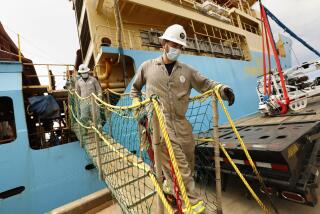Environmentalists Attack Plans to Use Cyanide in Gold-Mining Operations
- Share via
CIMA, Calif. — Plans by a group of Canadian investors to use a controversial gold-mining technology at a site within the proposed Mojave National Park have come under attack by environmentalists, who claim that it will dry up a perennial spring and attract wildlife to ponds of cyanide-laced water.
Opponents, including the Sierra Club Legal Defense Fund and the Wilderness Society, see their battle against the Viceroy Gold Mine as the first stand in a larger war against cyanide heap-leach mining, which is proliferating across the West.
“We are using this issue to draw attention to a process that we think is destroying the desert,” said Patricia Shifferle, regional director of the Wilderness Society of San Francisco. “When push comes to shove, wildlife loses out to these mines.”
The method saturates heaps of ore dug from nearby strip mines with a weak cyanide solution, which extracts microscopic grains of gold. The solution, which is typically 0.1% cyanide, is then diverted from the heaps to collecting ponds. Additional processes are used to filter the gold from the solution.
‘Great Deal of Homework’
Ross Fitzpatrick, president of Vancouver-based Viceroy Resource Corp., insisted that his project will be safe and will include safeguards to prevent wildlife such as migrating birds from trying to land on the mine’s ponds of toxic cyanide solution.
“Our view from the beginning is that we have the objective of mitigating all environmental impacts we can,” Fitzpatrick said. “We have done a great deal of homework, . . . and there is no reason from an environmental point of view why this mine cannot go through.”
The mine would sit in the Castle Mountains--a row of jagged peaks and gray volcanic rock that rises above the eastern Mojave Desert about 100 miles south of Las Vegas. The barren range is part of the East Mojave National Scenic Area and managed by the U.S. Bureau of Land Management. It is included in land designated for national park status in legislation sponsored by Sen. Alan Cranston (D-Calif.) that is now pending in Congress.
Fitzpatrick estimated that the mine will take $40 million worth of gold from 2.8 million tons of crushed ore each year. It will also gouge a hole in the mountains 2,200 feet across and 600 feet deep.
Spurred by the rising price of gold and advances in cyanide heap-leach technology, Viceroy is one of many mining companies that have been attracted to the Mojave Desert in recent years. Mining company officials said improved heap-leach techniques have enabled them to make a profit from claims considered “mined out” only 20 years ago.
Bureau of Land Management officials call it a gold rush. In 1975, there were no cyanide heap-leach mines in the Mojave Desert, officials said. Today there are five on public land alone--including the Mesquite Mine near Brawley, which takes $60 million worth of gold a year--and permits are pending on six more. In Nevada, more than 60 such mines have sprung up in the last 10 years, officials said.
At nearly all of these mines, which are usually monitored by local regional water quality control boards and state safety and health officials, birds and small mammals have turned up dead near ore heaps and cyanide ponds, authorities said.
Typically, only a few dozen birds are found dead at a given mine each year. But in August, 1986, 900 birds including ducks, pelicans and great horned owls were killed at a gold mine’s cyanide ponds near the central Nevada community of Gabbs. That mine has since neutralized exposed cyanide and covered its ponds with nets, Nevada Mining Assn. officials said.
In response the problem in Nevada, mining companies there have reached an agreement with the Nevada Department of Wildlife to take steps to eliminate wildlife mortality in and around heap leach operations. These steps include lowering cyanide concentrations in exposed ponds, covering ponds that carry lethal levels of the chemical and implementing methods of scaring off animals, Nevada Mining Assn. officials said.
Two Accidental Spills
Separately, San Bernardino County health and safety officials said there have been two large accidental spills of cyanide solution in the last three months at a mine near Viceroy’s claims called the Morning Star Mine. Reports of birds and animals killed by drinking or somehow absorbing lethal doses of cyanide at that mine are being investigated by the state Department of Fish and Game.
“I have yet to have it proved that cyanide has anything to do with these bird kills,” said Fred DeVries, senior consultant to cyanide manufacturer E. I. du Pont de Nemours & Co. of Wilmington, Del. “I would want to be darn sure we know what is killing the animals before we take action.”
Nonetheless, U.S. Bureau of Mines officials are concerned about a dearth of independent research on the effects of cyanide on wildlife.
“There are a lot of questions that need to be resolved,” said Bureau of Mines spokesman Glenn Palmer.
Robert Stebbins, emeritus professor of zoology at UC Berkeley and an active opponent of heap-leach mining, agreed.
“I feel almost sick at heart that this is happening,” said Stebbins. “My deeply felt view, just from knowing what is out there in the way of wildlife and how strongly that wildlife is drawn to water--from puddles to moist soil--is that it will have a strong impact.”
Independent Study Begins
The Patuxent Wildlife Research Center of Laurel, Md., responding to reports of migrating birds and mammals turning up dead at heap-leach mines in California and Nevada, this month launched the first independent study of the effects of cyanide on migrating waterfowl.
Despite the controversy swirling around heap-leach mining, Fitzpatrick said his company has already invested $13 million in mining claims, exploratory drilling and other start-up procedures and has no intention of walking away from the project.
Fitzpatrick said his mine will use all known methods of preventing harm to wildlife. For example, air cannons, strings of multicolored flags and floating covers will be installed at the mine’s cyanide ponds to ward off thirsty birds and animals. The area will also be guarded by fences sunk deep into the earth to prevent intrusion by burrowing animals.
He said that once the gold source has been depleted, the company will clean up the area and replant natural vegetation wherever possible.
Environmentalists are not convinced that the procedures will work. In fact, Bureau of Mines spokesman Palmer said, precautionary measures such as colored flags and air cannons often fail.
‘Birds Will Land’
“Ducks get bored with most attempts to scare them away,” Palmer said. “Once they realize there is no buckshot behind those cannons they realize there is no reason to be scared.” As for the colored flags, he said, “If there is a real need, the birds will land.”
Of particular concern to environmentalists is the threat to Piute Springs, a year-round stream gushing out of volcanic mountains about 12 miles southeast of the proposed Viceroy Mine. The stream is a haven for wildlife ranging from bighorn sheep to endangered birds such as Bell’s vireo and Bendire’s thrasher.
A U.S. Geological Survey report filed in 1983 said the outflow at Piute Springs roughly equals the amount of water stored each year in the underground aquifer of Lanfair Valley, Viceroy Mine’s main source of water.
Environmentalists point to that study as reason to fear that the mining operation, which intends to draw about 1,100 acre-feet of water from the aquifer each year, could sap the spring.
“There is insufficient recharge anywhere else in the area to provide water for Piute Springs,” said Robert Curry, a professor of environmental geology at UC Santa Cruz, who has joined the fight against Viceroy.
“There is no acceptable amount of water that can be safely extracted because Piute Springs is marginal in dry years,” added Curry, who based his assertions on the USGS study. “That spring could go dry.”
Findings Disputed
But Fitzpatrick said hydrologists hired by his company dispute the USGS findings.
“The recharge to Lanfair Valley is a total of 3,000 acre-feet a year,” Fitzpatrick said. “Of that our usage would be 700 to 1,140 acre-feet a year.”
The issue may have to be resolved in the courts, said Sierra Club Legal Defense Fund attorney Deborah Reames. “Our goal is not to stop the mine, just to make certain it doesn’t harm the wilderness area,” Reames said.
As it stands, appeals filed by Reames and representatives of at least three other environmental groups figured in a recent Bureau of Land Management decision to withdraw an earlier approval of Viceroy’s plan of operations and to conduct an environmental impact study of the project.
“I didn’t expect this much controversy,” said Ron Yakota, acting district manager of the BLM office in Riverside. “We are hoping it will quiet down, but I don’t think it will.”
Six weeks ago, the company submitted a new plan of operations that reduced the amount of water and land the mine would use.
Nonetheless, some opponents say the project cannot be mitigated.
“We say the natural and cultural resources far outweigh what this gold is worth,” said Peter Burke, president of the Citizens for Mojave National Park. “If you believe that the mine will restore the land you believe in the Easter Bunny.”
Supports Cranston’s Plan
Burke’s group supports Cranston’s proposed California Desert Protection Act, which would set aside 1.5 million acres of desert lands east of Barstow as the nation’s 50th national park. It would also preserve 4.5 million acres of land now controlled by the BLM as wilderness and expand Death Valley and Joshua Tree national monuments and turn them into national parks.
The bill is currently pending before the Senate Energy and Natural Resources Committee.
Viceroy officials and the mining industry in general oppose the protection bill, which would restrict certain operations and curtail deep exploratory drilling, said Chris Mitchell, Viceroy’s vice president.
Beyond that, industry officials said the gold rush has created thousands of jobs in the Southwestern United States and added millions of dollars to the gross national product.
“There are no easy choices,” Mitchell said. “You can have mining cognizant of the environment, or you can have no mining and eventually you won’t have an economy.”
HEAP LEACH MINING
Ore is taken from a mine and dumped into a huge crusher (1) which turns it into an even finer ore. From there the ore travels up a conveyor belt and is dumped into huge mounds (2). Water taken from local wells is mixed with cyanide to form a solution that is sprayed or dripped over these mounds (3). The solution, which is clear and smells of almonds, picks up gold particles as it percolates down through the heap (4) that lies on an impermeable plastic lining, and is then diverted from the heaps to
giant collecting ponds (5). From these ponds it is pumped into nearby ground units where it is forced through filters of coconut shell charcoal that take the gold out of the solution (6). Additional processes are used to purify the metal (7). Cyanide solution is recycled.
More to Read
Sign up for Essential California
The most important California stories and recommendations in your inbox every morning.
You may occasionally receive promotional content from the Los Angeles Times.











